Aircraft Engine Bleed Valve Prognostics Using Multiclass Gated Recurrent Unit
Abstract
1. Introduction
2. Related Work
2.1. Prognostics Modeling Approaches
2.2. Hidden Markov Modeling
2.3. Health Stage Classification Approaches
2.4. Failure Mode Classification Approaches
2.5. Binary versus Multiclass Classification Approaches
2.6. Prognostics versus Diagnostics
3. Case Study
3.1. Description
3.2. Data
- Maintenance event data detailing the maintenance actions performed on the system;
- Sensor data describing the raw sensor signals recorded in different flights
- Removals (repair + re-install);
- Time-scheduled maintenance interventions.
- Bleed Air Check Valve
- High Stage Regulator (HSR)
- High Stage Valve (HSV)
- Precooler
- Bleed Air Regulator (BAR)
- Precooler Outlet Temperature Sensor
- Bleed Air Overtemperature Sensor
- Precooler Control Valve (PCCV)
- Isolation Valve (ISOV)
4. Methods
4.1. Problem Formulation
4.2. Modeling Approach
Data Pre-Processing
4.3. Classifier Model
4.3.1. Recurrent Neural Networks
4.3.2. Model Optimization
4.4. Visual Assessment
4.4.1. Receiver Operating Characteristic Curve
4.4.2. Risk Plot
5. Results
5.1. Research Question
Multiclass models based on the gated recurrent unit (GRU) neural network can achieve a macro-average area and micro-average area under the model’s ROC curve (AUC) above 50%.
5.2. Confusion Matrix
5.3. Multiclass Receiver Operating Characteristics Curve
5.4. Precision–Recall Plot
5.5. Risk Plots
5.6. Summary
6. Conclusions
Author Contributions
Funding
Institutional Review Board Statement
Informed Consent Statement
Data Availability Statement
Conflicts of Interest
References
- Xu, Z.; Saleh, J.H. Machine learning for reliability engineering and safety applications: Review of current status and future opportunities. Reliab. Eng. Syst. Saf. 2021, 211, 107530. [Google Scholar] [CrossRef]
- Zio, E. Prognostics and Health Management (PHM): Where are we and where do we (need to) go in theory and practice. Reliab. Eng. Syst. Saf. 2022, 218, 108119. [Google Scholar] [CrossRef]
- Zio, E. Reliability engineering: Old problems and new challenges. Reliab. Eng. Syst. Saf. 2009, 94, 125–141. [Google Scholar] [CrossRef]
- Goebel, K.; Daigle, M.; Saxena, A.; Sankararaman, S.; Roychoudhury, I.; Celaya, J. Prognostics: The Science of Making Predictions, 1st ed.; CreateSpace Independent Publishing Platform: Scotts Valley, CA, USA, 2017. [Google Scholar]
- Tamilselvan, P.; Wang, P. Failure diagnosis using deep belief learning based health state classification. Reliab. Eng. Syst. Saf. 2013, 115, 124–135. [Google Scholar] [CrossRef]
- Niu, G.; Yang, B.S.; Pecht, M. Development of an optimized condition-based maintenance system by data fusion and reliability-centered maintenance. Reliab. Eng. Syst. Saf. 2010, 95, 786–796. [Google Scholar] [CrossRef]
- Baraldi, P.; Razavi-Far, R.; Zio, E. Classifier-ensemble incremental-learning procedure for nuclear transient identification at different operational conditions. Reliab. Eng. Syst. Saf. 2011, 96, 480–488. [Google Scholar] [CrossRef]
- Li, Z.; Wu, D.; Hu, C.; Terpenny, J. An ensemble learning-based prognostic approach with degradation-dependent weights for remaining useful life prediction. Reliab. Eng. Syst. Saf. 2019, 184, 110–122. [Google Scholar] [CrossRef]
- ISO13381-1:(e); Diagnostics of Machines-Prognostics Part 1: General Guidelines. Technical Committee: ISO/TC 108/SC 5 Condition Monitoring and Diagnostics of Machine Systems; ISO: Geneva, Switzerland, 2004; p. 14.
- Daigle, M.J.; Goebel, K. A Model-based Prognostics Approach applied to Pneumatic Valves. Int. J. Progn. Health Manag. 2011, 2, 84–99. [Google Scholar]
- Fink, O.; Zio, E.; Weidmann, U. Predicting component reliability and level of degradation with complex-valued neural networks. Reliab. Eng. Syst. Saf. 2014, 121, 198–206. [Google Scholar] [CrossRef]
- Ramasso, E. Contribution of belief functions to hidden markov models with an application to fault diagnosis. In Proceedings of the 2009 IEEE International Workshop on Machine Learning for Signal Processing, Grenoble, France, 1–4 September 2009. [Google Scholar] [CrossRef]
- Saxena, A.; Goebel, K.; Simon, D.; Eklund, N. Damage propagation modeling for aircraft engine run-to-failure simulation. In Proceedings of the 2008 International Conference on Prognostics and Health Management, Denver, CO, USA, 6–9 October 2008. [Google Scholar] [CrossRef]
- Ramasso, E.; Denoeux, T. Making Use of Partial Knowledge About Hidden States in HMMs: An Approach Based on Belief Functions. IEEE Trans. Fuzzy Syst. 2014, 22, 395–405. [Google Scholar] [CrossRef]
- Ramasso, E.; Gouriveau, R. Remaining Useful Life Estimation by Classification of Predictions Based on a Neuro-Fuzzy System and Theory of Belief Functions. IEEE Trans. Reliab. 2014, 63, 555–566. [Google Scholar] [CrossRef]
- Peng, Y.; Wang, H.; Wang, J.; Liu, D.; Peng, X. A modified echo state network based remaining useful life estimation approach. In Proceedings of the 2012 IEEE Conference on Prognostics and Health Management, Denver, CO, USA, 18–21 June 2012. [Google Scholar] [CrossRef]
- Javed, K.; Gouriveau, R.; Zemouri, R.; Zerhouni, N. Features Selection Procedure for Prognostics: An Approach Based on Predictability. IFAC Proc. Vol. 2012, 45, 25–30. [Google Scholar] [CrossRef]
- Kim, H.E.; Tan, A.C.C.; Mathew, J. New machine prognostics approach based on health state probability estimation. Aust. J. Mech. Eng. 2011, 8, 79–89. [Google Scholar] [CrossRef]
- de Padua Moreira, R.; Nascimento, C.L. Prognostics of aircraft bleed valves using a SVM classification algorithm. In Proceedings of the 2012 IEEE Aerospace Conference, Big Sky, MO, USA, 3–10 March 2012. [Google Scholar] [CrossRef]
- Louen, C.; Ding, S.X.; Kandler, C. A new framework for remaining useful life estimation using Support Vector Machine classifier. In Proceedings of the 2013 Conference on Control and Fault-Tolerant Systems (SysTol), Nice, France, 9–11 October 2013. [Google Scholar] [CrossRef]
- Castilho, H.M.; Nascimento, C.L.; Vianna, W.O.L. Aircraft bleed valve fault classification using support vector machines and classification trees. In Proceedings of the 2018 Annual IEEE International Systems Conference (SysCon), Vancouver, BC, Canada, 23–26 April 2018. [Google Scholar] [CrossRef]
- Allegorico, C.; Mantini, V. A data-driven approach for on-line gas turbine combustion monitoring using classification models. In Proceedings of the PHM Society European Conference, Nantes, France, 8–10 July 2014; Volume 2. [Google Scholar]
- Liu, C.L.; Hsaio, W.H.; Tu, Y.C. Time Series Classification With Multivariate Convolutional Neural Network. IEEE Trans. Ind. Electron. 2019, 66, 4788–4797. [Google Scholar] [CrossRef]
- Li, K.; Wu, Y.; Nan, Y.; Li, P.; Li, Y. Hierarchical multi-class classification in multimodal spacecraft data using DNN and weighted support vector machine. Neurocomputing 2017, 259, 55–65. [Google Scholar] [CrossRef]
- Shen, F.; Chen, C.; Yan, R.; Gao, R.X. Bearing fault diagnosis based on SVD feature extraction and transfer learning classification. In Proceedings of the 2015 Prognostics and System Health Management Conference (PHM), Beijing, China, 21–23 October 2015. [Google Scholar] [CrossRef]
- Wang, P.; Tamilselvan, P.; Hu, C. Health diagnostics using multi-attribute classification fusion. Eng. Appl. Artif. Intell. 2014, 32, 192–202. [Google Scholar] [CrossRef]
- Lall, P.; Gupta, P.; Angral, A. Anomaly Detection and Classification for PHM of Electronics Subjected to Shock and Vibration. IEEE Trans. Compon. Packag. Manuf. Technol. 2012, 2, 1902–1918. [Google Scholar] [CrossRef]
- Li, X.; Zhang, W.; Ma, H.; Luo, Z.; Li, X. Deep learning-based adversarial multi-classifier optimization for cross-domain machinery fault diagnostics. J. Manuf. Syst. 2020, 55, 334–347. [Google Scholar] [CrossRef]
- Baptista, M.L.; Henriques, E.M.; Prendinger, H. Classification prognostics approaches in aviation. Measurement 2021, 182, 109756. [Google Scholar] [CrossRef]
- Janasak, K.; Beshears, R. Diagnostics To Prognostics—A Product Availability Technology Evolution. In Proceedings of the 2007 Proceedings—Annual Reliability and Maintainability Sympsoium, Orlando, FL, USA, 22–25 January 2007. [Google Scholar] [CrossRef]
- Zein-Sabatto, S.; Bodruzzaman, M.; Mgaya, R.; Behbahani, A. Distributed Onboard Diagnostic Methodology for Next Generation Turbine Engines. In Proceedings of the 46th AIAA/ASME/SAE/ASEE Joint Propulsion Conference Exhibit. American Institute of Aeronautics and Astronautics, Nashville, TN, USA, 25–28 July 2010. [Google Scholar] [CrossRef]
- Kumar, A.; Chinnam, R.B.; Tseng, F. An HMM and polynomial regression based approach for remaining useful life and health state estimation of cutting tools. Comput. Ind. Eng. 2019, 128, 1008–1014. [Google Scholar] [CrossRef]
- Sebok, M. Condition Analysis of Electrical Machines by Thermovision. Przegląd Electhrotecknizny 2020, 1, 49–52. [Google Scholar] [CrossRef]
- Zhang, J.; Jiang, N.; Li, H.; Li, N. Online health assessment of wind turbine based on operational condition recognition. Trans. Inst. Meas. Control 2018, 41, 2970–2981. [Google Scholar] [CrossRef]
- Baptista, M.L.; Henriques, E.M.P.; Goebel, K. A self-organizing map and a normalizing multi-layer perceptron approach to baselining in prognostics under dynamic regimes. Neurocomputing 2021, 456, 268–287. [Google Scholar] [CrossRef]
- Celisse, A.; Marot, G.; Pierre-Jean, M.; Rigaill, G. New efficient algorithms for multiple change-point detection with reproducing kernels. Comput. Stat. Data Anal. 2018, 128, 200–220. [Google Scholar] [CrossRef]
- Arlot, S.; Celisse, A.; Harchaoui, Z. A kernel multiple change-point algorithm via model selection. J. Mach. Learn. Res. 2019, 20, 1–56. [Google Scholar]
- Pearson, R.K.; Neuvo, Y.; Astola, J.; Gabbouj, M. The class of generalized hampel filters. In Proceedings of the 2015 23rd European Signal Processing Conference (EUSIPCO), Nice, France, 31 August–4 September 2015. [Google Scholar] [CrossRef]
- Coble, J.; Hines, J.W. Identifying Suitable Degradation Parameters for Individual-Based Prognostics. In Diagnostics and Prognostics of Engineering Systems; IGI IGI Global: Hershey, PA, USA, 2013; pp. 135–150. [Google Scholar] [CrossRef]
- Vamos, C.; Craciun, M. Automatic Trend Estimation; Springer: Berlin/Heidelberg, Germany, 2013. [Google Scholar] [CrossRef]
- Breiman, L. Random forests. Mach. Learn. 2001, 45, 5–32. [Google Scholar] [CrossRef]
- Cho, K.; van Merrienboer, B.; Gulcehre, C.; Bahdanau, D.; Bougares, F.; Schwenk, H.; Bengio, Y. Learning Phrase Representations using RNN Encoder–Decoder for Statistical Machine Translation. In Proceedings of the 2014 Conference on Empirical Methods in Natural Language Processing (EMNLP), Doha, Qatar, 25–29 October 2014. [Google Scholar] [CrossRef]
- Lee, J.; Tashev, I. High-level feature representation using recurrent neural network for speech emotion recognition. In Proceedings of the ISCA Interspeech 2015, Dresden, Germany, 11 September 2015. [Google Scholar] [CrossRef]
- Chien, J.T.; Shen, C. Stochastic Recurrent Neural Network for Speech Recognition. In Proceedings of the ISCA Interspeech 2017, Stockholm, Sweden, 20–24 August 2017. [Google Scholar] [CrossRef]
- Mikolov, T.; Karafiát, M.; Burget, L.; Černocký, J.; Khudanpur, S. Recurrent neural network based language model. In Proceedings of the ISCA Interspeech 2010, Chiba, Japan, 26–30 September 2010. [Google Scholar] [CrossRef]
- Morioka, T.; Iwata, T.; Hori, T.; Kobayashi, T. Multiscale recurrent neural network based language model. In Proceedings of the Interspeech 2015, Dresden, Germany, 11 September 2015. [Google Scholar] [CrossRef]
- Shini, R.S.; Kumar, V.A. Recurrent Neural Network based Text Summarization Techniques by Word Sequence Generation. In Proceedings of the IEEE 2021 6th International Conference on Inventive Computation Technologies (ICICT), Coimbatore, India, 20–22 January 2021. [Google Scholar] [CrossRef]
- Hochreiter, S.; Schmidhuber, J. Long Short-Term Memory. Neural Comput. 1997, 9, 1735–1780. [Google Scholar] [CrossRef] [PubMed]
- Wang, J.; Zhan, C.; Yu, D.; Zhao, Q.; Xie, Z. Rolling bearing fault diagnosis method based on SSAE and softmax classifier with improved K-fold cross-validation. Meas. Sci. Technol. 2022, 33, 105110. [Google Scholar] [CrossRef]
- Koidl, K. Loss Functions in Classification Tasks. P.hD. Thesis, School of Computer Science and Statistic Trinity College, Dublin, Ireland, 2013. [Google Scholar]
- Mirjalili, S. Genetic Algorithm. In Studies in Computational Intelligence; Springer International Publishing: Berlin/Heidelberg, Germany, 2018; pp. 43–55. [Google Scholar] [CrossRef]
- Dracopoulos, D.C.; Dracopoulos, D.C. Genetic algorithms. In Evolutionary Learning Algorithms for Neural Adaptive Control; Springer: London, UK, 1997; pp. 111–131. [Google Scholar]
- Saxena, A.; Celaya, J.; Saha, B.; Saha, S.; Goebel, K. Evaluating algorithm performance metrics tailored for prognostics. In Proceedings of the 2009 IEEE Aerospace Conference, Big Sky, MO, USA, 7–14 March 2009. [Google Scholar] [CrossRef]
- Goebel, K.; Saxena, A.; Saha, S.; Saha, B.; Celaya, J. Prognostic Performance Metrics. In Machine Learning and Knowledge Discovery for Engineering Systems Health Management; Chapman and Hall/CRC: Boca Raton, FL, USA, 2016; pp. 147–177. [Google Scholar] [CrossRef]
- Japkowicz, N.; Shah, M. Evaluating Learning Algorithms: A Classification Perspective; Cambridge University Press: Cambridge, UK, 2011. [Google Scholar]
- Kohavi, R.; Provost, F. On applied research in machine learning. Appl. Mach. Learn. Knowl. Discov. Process 1998, 30, 127–132. [Google Scholar]
- Sokolova, M.; Japkowicz, N.; Szpakowicz, S. Beyond accuracy, F-score and ROC: A family of discriminant measures for performance evaluation. In Proceedings of the Australasian Joint Conference on Artificial Intelligence; Springer: Berlin/Heidelberg, Germany, 2006; pp. 1015–1021. [Google Scholar]
- Fawcett, T. An introduction to ROC analysis. Pattern Recognit. Lett. 2006, 27, 861–874. [Google Scholar] [CrossRef]
- Tharwat, A. Classification assessment methods. Appl. Comput. Inform. 2020, 17, 168–192. [Google Scholar] [CrossRef]
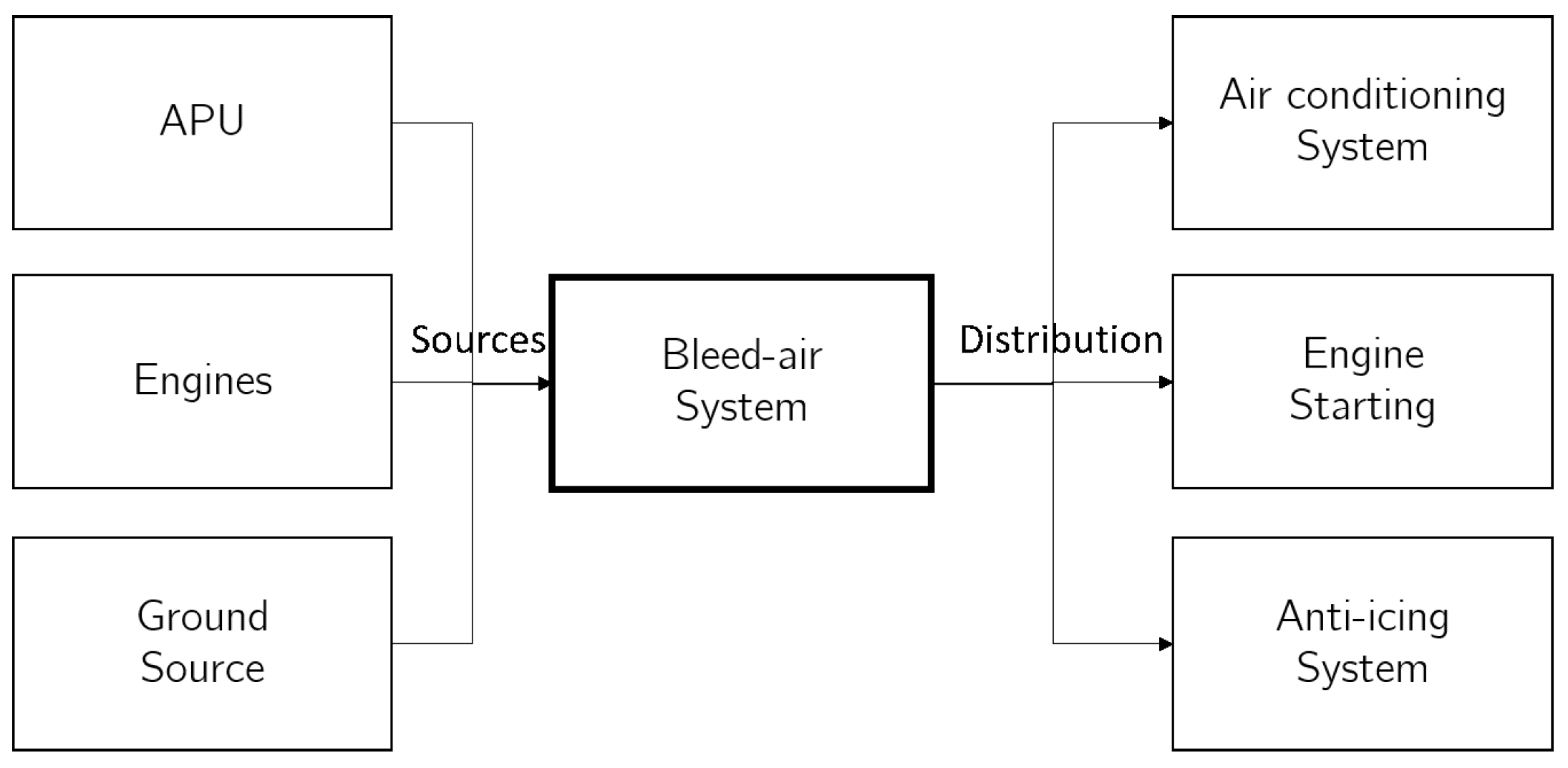
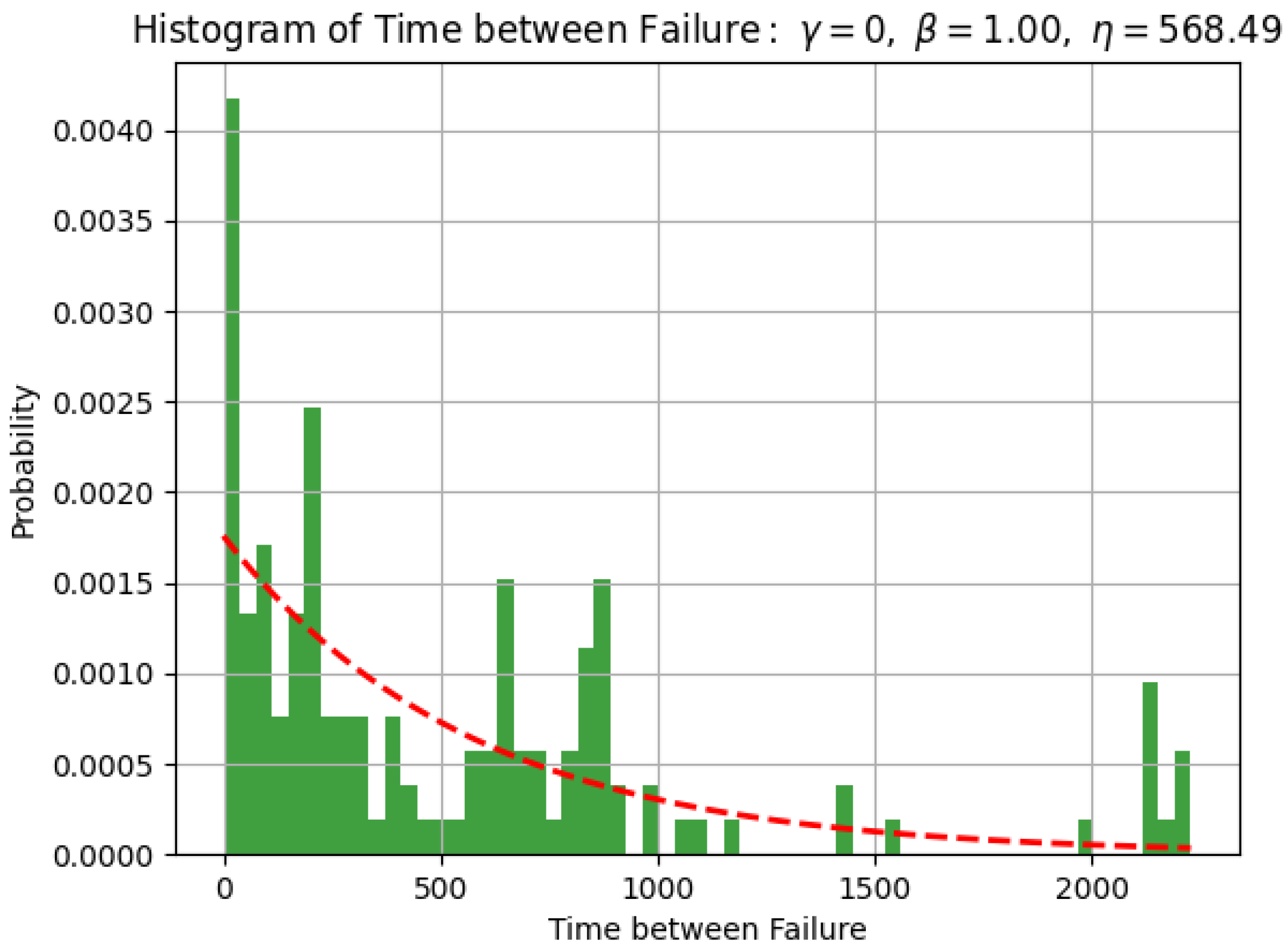



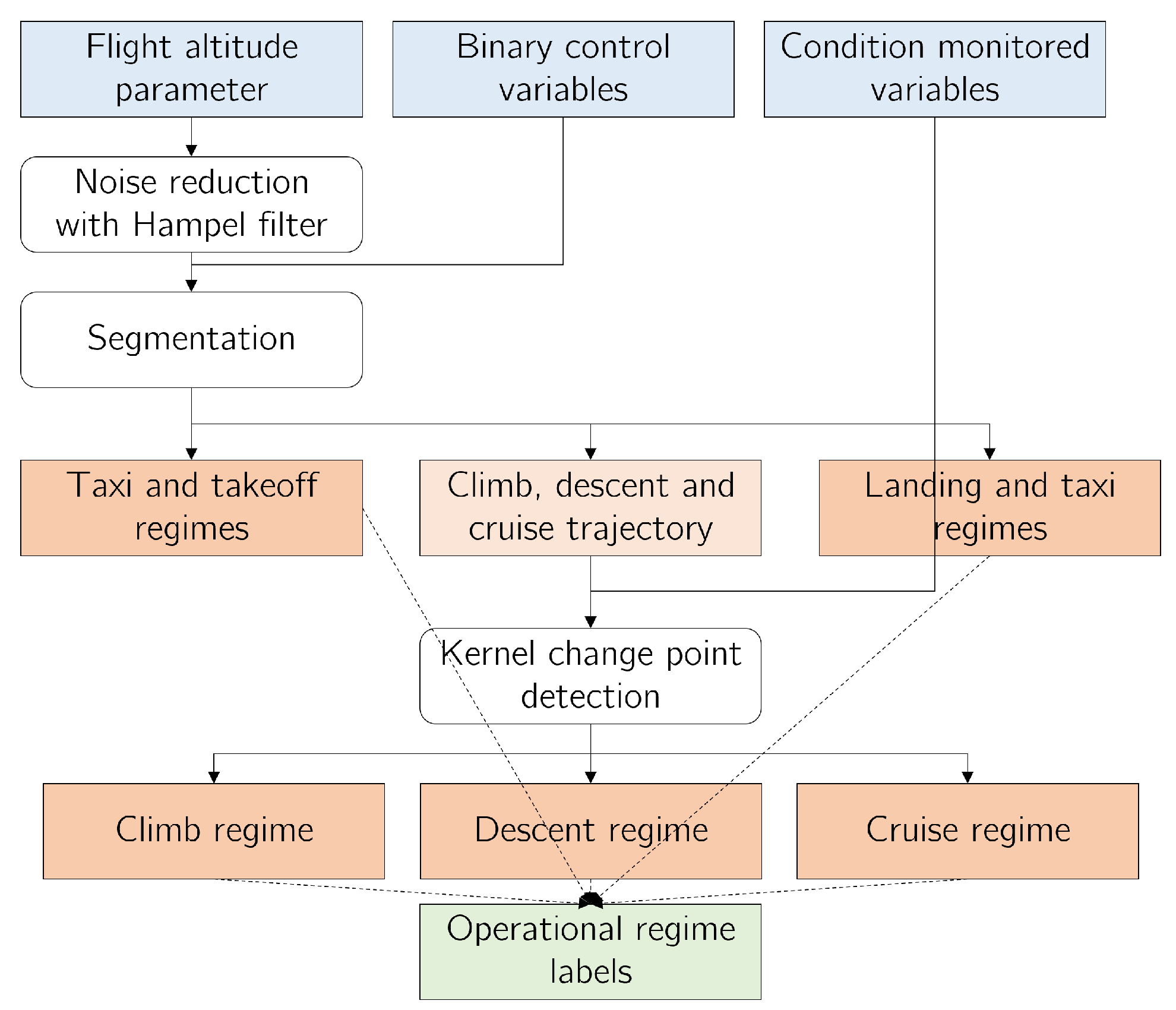
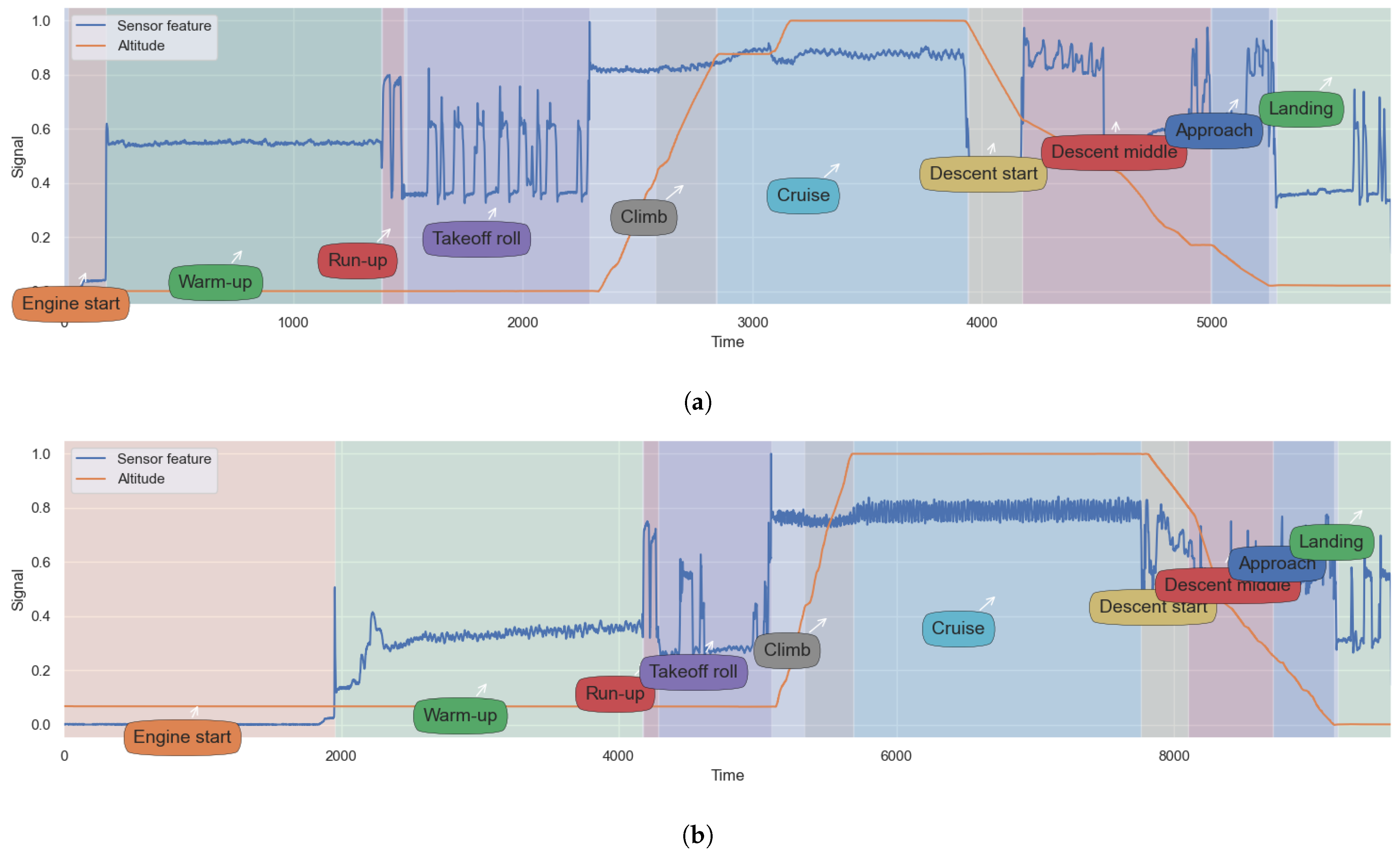



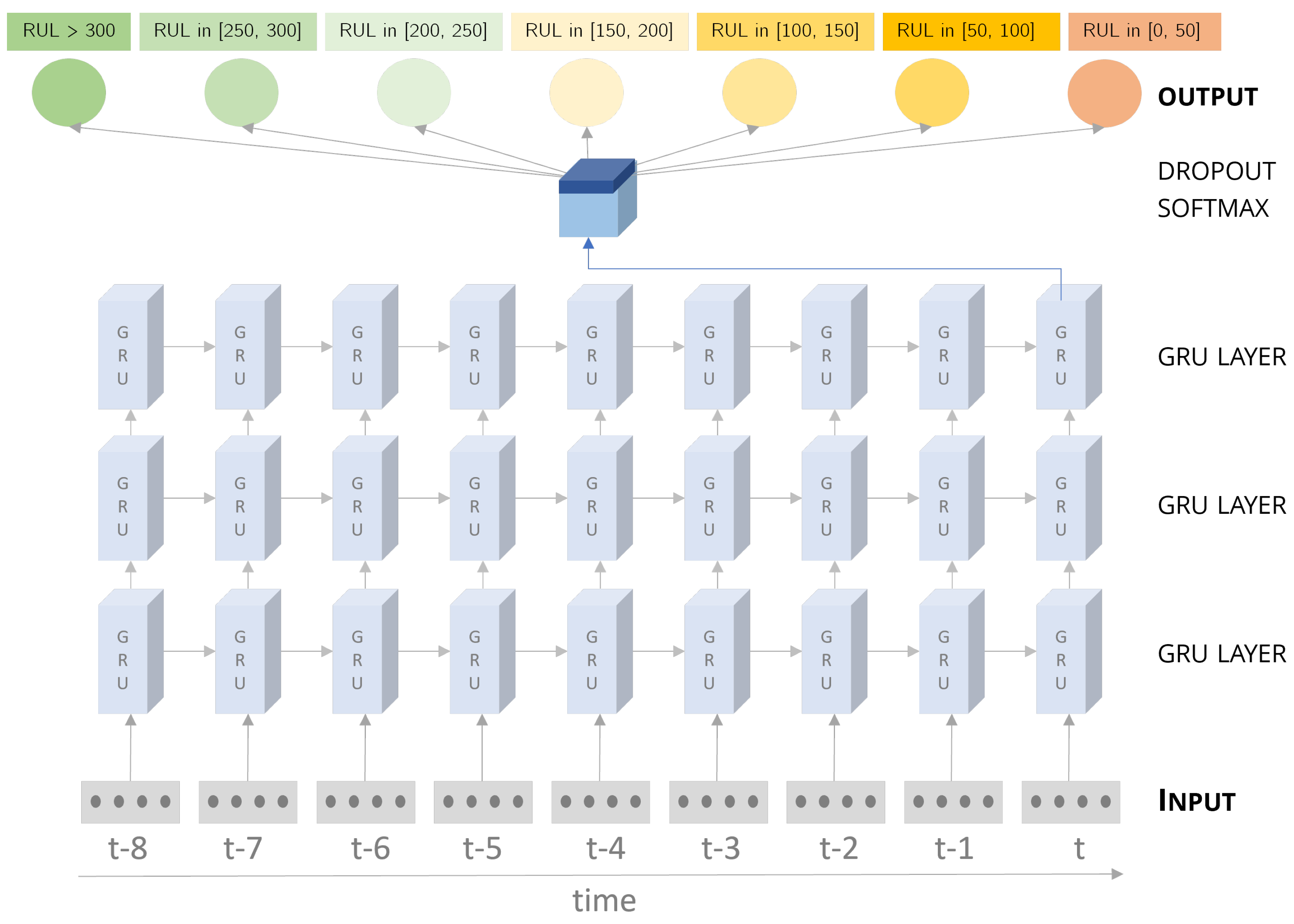
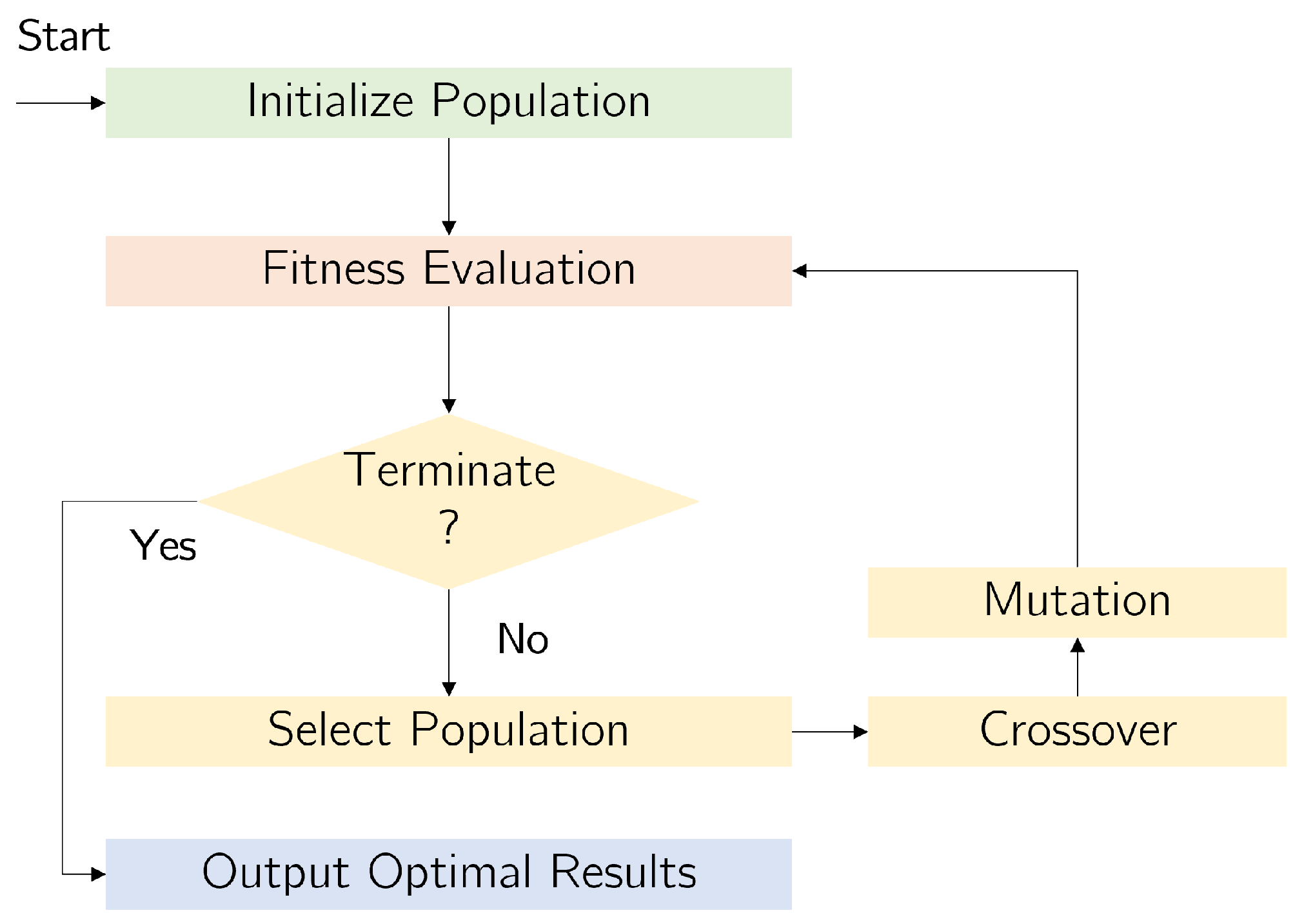


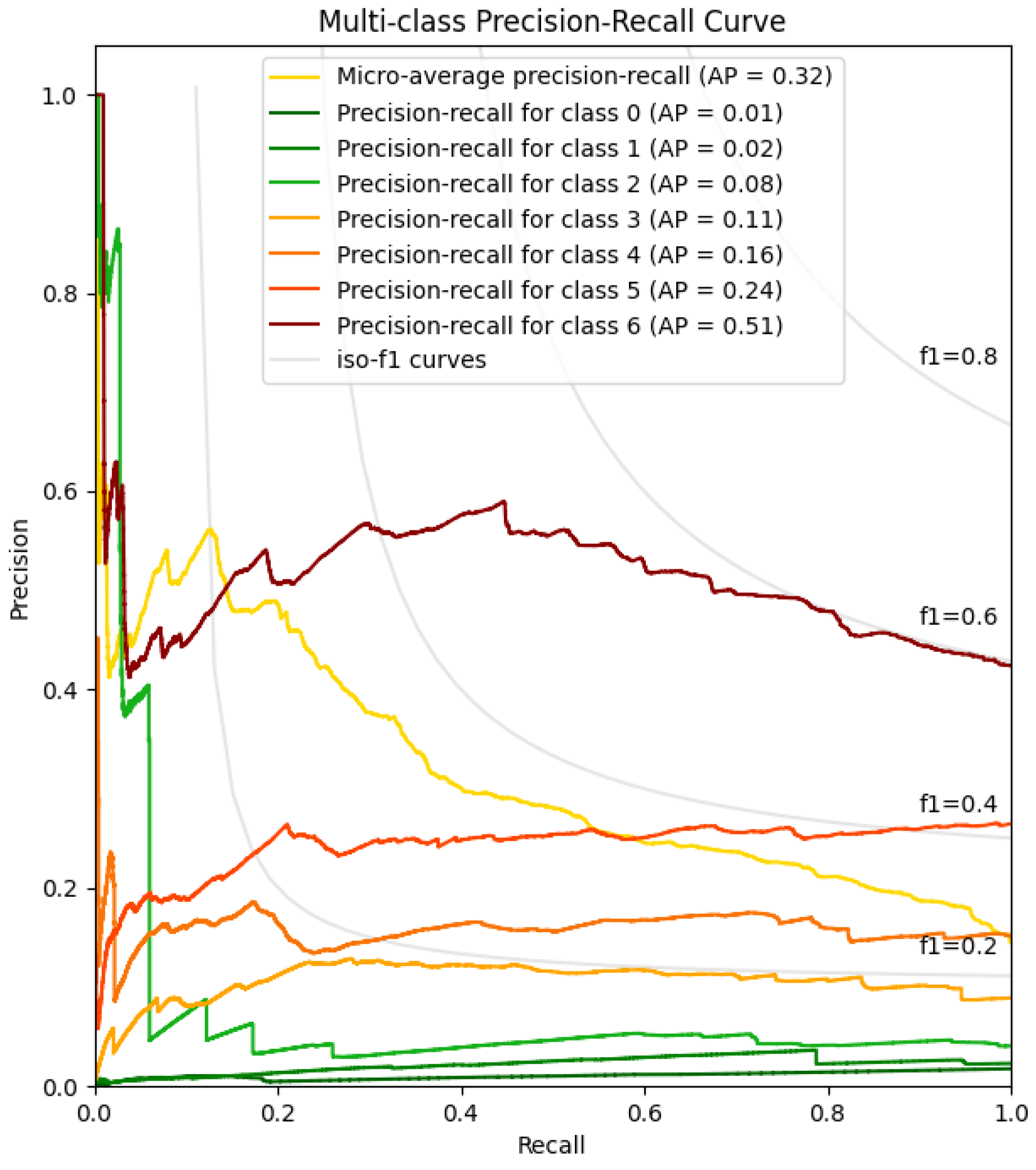

| Phase | Regime | Description |
|---|---|---|
| Engine start | Aircraft engine starting. | |
| Warm-up | Warm-up stage serves for warming up the engines until take-off power can be accepted by the engine. | |
| Run-up | During run-up engine run-up aims to ensure rt that all aircraft systems are running normal. | |
| Takeoff | Takeoff roll | Takeoff roll is the final stage of takeoff. The airplane is accelerated from standstill to an airborne airspeed. |
| Climb | Climb | Climb is the period during which the aircraft climbs to a predefined cruising altitude. |
| Cruise | Cruise | Cruise is between the climb and descent phase. |
| Descent | Descent start | Start descent is the period during which the aircraft starts to decrease altitude and get ready for approach and landing. |
| Descent middle | Final descent period. | |
| Approach | During the approach phase, the aircraft is beginning its descent for landing. | |
| Landing | Landing | This phase starts when there is a crossing of the runway threshold. |
| Bounds | |||
|---|---|---|---|
| Description | Superior | Inferior | |
| 0 | Will happen in more 300 days | 300 | |
| 1 | Will happen in 250 to 300 days | 300 | 250 |
| 2 | Will happen in 200 to 250 days | 250 | 200 |
| 3 | Will happen in 150 to 200 days | 200 | 150 |
| 4 | Will happen in 100 to 150 days | 150 | 100 |
| 5 | Will happen in 50 to 100 days | 100 | 50 |
| 6 | Will happen in 0 to 50 days | 50 | 0 |
| Parameter | Tested Range |
|---|---|
| Window size | [1, 100] |
| Number of neurons in the hidden state | [50, 150] |
| Batch size | [1, 50] |
| Epoch size | [10, 500] |
| Initial learning rate | [0.0001, 0.001] |
| Loss function | Cross Entropy Loss |
| Actual | Predicted | |
|---|---|---|
| Negative | Positive | |
| Negative | True negative (TN) | False positive (FP) |
| Positive | False negative (FN) | True positive (TP) |
Disclaimer/Publisher’s Note: The statements, opinions and data contained in all publications are solely those of the individual author(s) and contributor(s) and not of MDPI and/or the editor(s). MDPI and/or the editor(s) disclaim responsibility for any injury to people or property resulting from any ideas, methods, instructions or products referred to in the content. |
© 2023 by the authors. Licensee MDPI, Basel, Switzerland. This article is an open access article distributed under the terms and conditions of the Creative Commons Attribution (CC BY) license (https://creativecommons.org/licenses/by/4.0/).
Share and Cite
Baptista, M.L.; Prendinger, H. Aircraft Engine Bleed Valve Prognostics Using Multiclass Gated Recurrent Unit. Aerospace 2023, 10, 354. https://doi.org/10.3390/aerospace10040354
Baptista ML, Prendinger H. Aircraft Engine Bleed Valve Prognostics Using Multiclass Gated Recurrent Unit. Aerospace. 2023; 10(4):354. https://doi.org/10.3390/aerospace10040354
Chicago/Turabian StyleBaptista, Marcia L., and Helmut Prendinger. 2023. "Aircraft Engine Bleed Valve Prognostics Using Multiclass Gated Recurrent Unit" Aerospace 10, no. 4: 354. https://doi.org/10.3390/aerospace10040354
APA StyleBaptista, M. L., & Prendinger, H. (2023). Aircraft Engine Bleed Valve Prognostics Using Multiclass Gated Recurrent Unit. Aerospace, 10(4), 354. https://doi.org/10.3390/aerospace10040354







